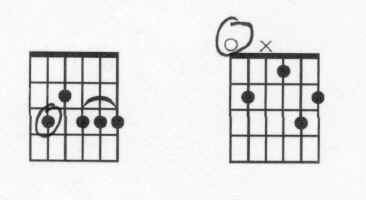Home
Tour Dates
Latest News
Recordings
Song Index
Lyrics
MP3 Page
Sheet Music
Photos
Biography
Booking
Press Kit Online
Workshops
FAQ
Links
Folk Alliance
Join Email List
Joel Speaks
COVID-19 PANDEMIC
Tip Jar
Contact
or send
email
to Joel
Swing Guitar For
Folkies
Or Jazz Guitar Rhythm 101 -- A first lesson
Nothing too intense here – this lesson is designed for the folk or bluegrass guitar player who is accustomed to accompanying songs with first position chords – usually those which contain open strings – big ol’ cowboy chords.
For a swing style, we will use “closed” chords, a.k.a. “barre” chords – movable positions that leave no string open. We also will tend to use extended chords (chords with numbers attached to their names) instead of simple major or minor triads.
When we play in a folk or bluegrass way in common time, we usually play an “oom-pah” rhythm by hitting a single bass string on the beat followed with a strum of the chord on the off-beat.
Swing rhythm on guitar is basically an "oom-pah" sound, too. But we get that beat a different way. The "OOM" is a downstroke over the chord you wish to play. The "PAH" follows as another downstroke, but this time you release the tension of your left hand just as, or just after you strike the strings. The strings are deadened on the offbeat “PAH,” yielding a more percussive sound.
In other words your right hand just strikes twice per beat – two identical downward strums. But that first strum is full and ringing (left hand pressing tight), and the second strum is dead and percussive (left hand relaxed).
Sometimes you might wish to "OOM" on every downstroke for variety, say during a bridge. In other words, no deadened strings during the offbeat for a sort of “tom-tom” effect.
Occasionally an upstroke between "oom" and "pah" can act as a "kicker" to enliven the rhythm. In such cases the "pah" may be silent. It's a nice trick, but don't overdo it.
Substitution chords:
Deciding which chords to substitute for others is a full time preoccupation for jazz players. Here are a few “baby steps” which will get you going with a convincing sound for swing music. Classic country music (such as in the music of Hank Williams Sr., and Merle Travis) or Western Swing (ala Bob Wills) use these substitutions all the time. Early jazz from the 20’s and 30’s also make common use of these everyday swing chords.
THE SIXTH CHORD:
When your song calls for a major chord, play a sixth instead. For example, if a G is called for, make it a G6, a C becomes a C6, etc.
What’s a sixth chord? It’s the major triad (1-3-5) adding one more note, the sixth note of the scale. So a G major chord (G-B-D) adds the sixth note of a G scale (E) to become G6 (G-B-D-E).
Here are three different positions to make a sixth chord. All are moveable. The root note is circled, so that you can easily relocate to play sixth chords all over the neck for all the possible chords:
THE NINTH CHORD:
When your song calls for a seventh chord (a common, or dominant 7th) play a ninth instead. For example, if a D7 is called for, make it a D9, a C7 becomes a C9, etc.
What’s a ninth chord? Properly, we’re talking about a dominant 9th. It is a FIVE note chord. It’s the (dominant) seventh chord adding the ninth note of the scale. So a D7 chord (D-F#-A-C) adds the ninth note of the D scale (E) to become D9 (D-F#-A-C-E).
Here are two popular ninth positions, both moveable. The root note is circled, so that you can relocate it to play all over the neck:
(Note: you can wrap your thumb around the sixth string on the first example to barre the fifth and sixth string at the same fret. On the second position, the root is the sixth string open [this is an E9] – if you move it around, leave the sixth string silent, and play the chord without a root.)
Try out these relatively easy chord substitutions with the oom-pah rhythm described above. Try some simple western swing songs, such as “Take Me Back To Tulsa” or “Stay All Night – Stay A Little Longer” or some old country classics such as “Hey Good Lookin – What Cha Got Cookin” or “Your Cheating Heart.” Some easy classic jazz standards might include “Jeepers Creepers,” “Lady Be Good” and “It’s A Sin To Tell A Lie.” Certain fiddle tunes, such as “Sally Goodwin” and many Irish tunes sound good with these chords and rhythm too!
Remember this is only the beginning of what could become an obsession with finding the "right" chord for the sound you want to hear!
©Joel Mabus 2001
plus 15,850 hits before 3/27/07 & the new server

